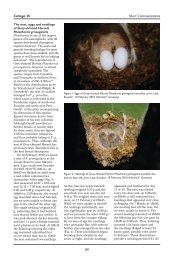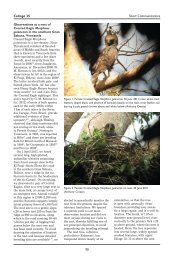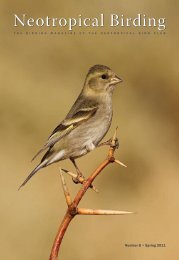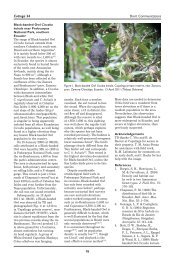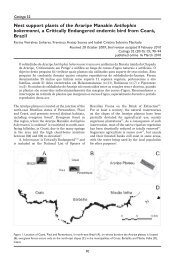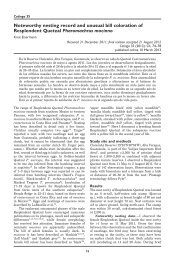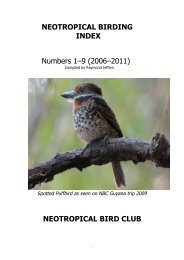Primer registro de la Golondrina de las Cavernas Petrochelidon ...
Primer registro de la Golondrina de las Cavernas Petrochelidon ...
Primer registro de la Golondrina de las Cavernas Petrochelidon ...
Create successful ePaper yourself
Turn your PDF publications into a flip-book with our unique Google optimized e-Paper software.
Cotinga 33<br />
<strong>Primer</strong> <strong>registro</strong> <strong>de</strong> <strong>la</strong> <strong>Golondrina</strong> <strong>de</strong> <strong>la</strong>s <strong>Cavernas</strong> <strong>Petrochelidon</strong><br />
fulva para Venezue<strong>la</strong> y Sur América<br />
Fi<strong>de</strong>l Esco<strong>la</strong>, Rosanna Calchi, Chey<strong>la</strong> Hernán<strong>de</strong>z y C<strong>la</strong>rk Casler<br />
Received 10 May 2010; final revision accepted 29 September 2010<br />
Cotinga 33 (2011): OL 61–62<br />
published online 16 March 2011<br />
We present the first records of Cave Swallow <strong>Petrochelidon</strong> fulva for Venezue<strong>la</strong>. Two individuals<br />
were photographed, on 11 January 2010, on the east shore of Lake Maracaibo, municipality of<br />
Santa Rita, in Zulia, western Venezue<strong>la</strong>. Four were subsequently observed in the same p<strong>la</strong>ce on<br />
12 February 2010. Cave Swallows are rare visitors to the southern Caribbean, and this constitutes<br />
the first record for South America.<br />
La <strong>Golondrina</strong> <strong>de</strong> <strong>la</strong>s <strong>Cavernas</strong> <strong>Petrochelidon</strong> fulva<br />
fue avistada en <strong>la</strong> costa oriental <strong>de</strong>l <strong>la</strong>go <strong>de</strong><br />
Maracaibo, municipio Santa Rita, Zulia (11 o 67’N<br />
22 o 24’O; Fig. 1). El primer avistamiento se realizó<br />
<strong>de</strong> manera casual el 11 <strong>de</strong> enero <strong>de</strong> 2010 a <strong>la</strong>s 11h00<br />
h. A ojo <strong>de</strong>snudo y con <strong>la</strong> ayuda <strong>de</strong> binocu<strong>la</strong>res,<br />
FE pudo observar una pareja <strong>de</strong> P. fulva en <strong>la</strong>s<br />
riberas <strong>de</strong>l <strong>la</strong>go, posadas en el cableado que surte<br />
<strong>de</strong> electricidad al muelle <strong>de</strong> <strong>la</strong> empresa Pralca,<br />
este muelle mi<strong>de</strong> aproximadamente 900 m. En este<br />
primer avistamiento <strong>la</strong>s golondrinas estaban muy<br />
quietas lo que hizo posible que fueran i<strong>de</strong>ntificadas<br />
y fotografiadas (Fig. 2). Posteriormente, el día 12 <strong>de</strong><br />
febrero <strong>de</strong> 2010, se realizó una vista al muelle para<br />
realizar nuevas observaciones. En esta segunda<br />
visita, a <strong>la</strong>s 10h40, se pudieron observar cuatro<br />
individuos, los cuales, mostrando mayor actividad<br />
que durante <strong>la</strong> visita anterior, se posaron en el<br />
cableado y vo<strong>la</strong>ron sobre <strong>la</strong>s aguas <strong>de</strong>l <strong>la</strong>go <strong>de</strong><br />
Maracaibo.<br />
Figura 1. Ubicación <strong>de</strong>l municipio Santa Rita, área <strong>de</strong><br />
avistamiento <strong>de</strong> <strong>Petrochelidon</strong> fulva.<br />
61<br />
En <strong>la</strong>s dos visitas un total <strong>de</strong> seis avistamientos<br />
<strong>de</strong> <strong>la</strong> especie fueron realizados, en los cuales,<br />
dos individuos mostraron un comportamiento que<br />
evi<strong>de</strong>nciaba que estaban alimentándose, también<br />
se les pudo ver interactuando con <strong>la</strong> <strong>Golondrina</strong> <strong>de</strong><br />
Agua Tachycineta albiventer y <strong>Golondrina</strong> Urbana<br />
Progne chalybea.<br />
I<strong>de</strong>ntificación.—A pesar que P. pyrrhonota (P.<br />
p. pyrhronota y me<strong>la</strong>nogaster) pue<strong>de</strong>n tener <strong>la</strong><br />
frente color cane<strong>la</strong> 1,6 en general <strong>la</strong> tienen <strong>de</strong> color<br />
ante o rufo b<strong>la</strong>nquecino 6 a diferencia <strong>de</strong> P. fulva<br />
que presenta <strong>la</strong> frente <strong>de</strong> color rojo <strong>la</strong>drillo. Aunado<br />
a lo anterior, P. fulva presenta <strong>la</strong> coloración ante<br />
o rufo en <strong>la</strong> parte superior <strong>de</strong>l pecho y f<strong>la</strong>ncos más<br />
marcada y extendida que P. pyrhronota 1 (Figs. 3–4).<br />
La co<strong>la</strong> ligeramente ahorquil<strong>la</strong>da <strong>de</strong> P. fulva (Fig.<br />
5) <strong>la</strong> diferencia <strong>de</strong> P. pyrrhonota que <strong>la</strong> presenta<br />
cuadrada 6 . La taxonomía para varias pob<strong>la</strong>ciones<br />
<strong>de</strong> <strong>Golondrina</strong> <strong>de</strong> <strong>la</strong>s <strong>Cavernas</strong> ha cambiado en los<br />
últimos años, sugiriendo <strong>la</strong> necesidad <strong>de</strong> estudios<br />
adicionales 2 . Restall et al. 6 seña<strong>la</strong> dos subespecies,<br />
P. f. pallida y P. f. cavico<strong>la</strong>, diferenciadas en que<br />
ésta última es más pequeña con una corona azul<br />
intenso, mejil<strong>la</strong>s y garganta rufas y rabadil<strong>la</strong><br />
Figura 2. Sitios <strong>de</strong> avistamiento <strong>de</strong> <strong>Petrochelidon</strong> fulva a lo<br />
<strong>la</strong>rgo <strong>de</strong>l cableado <strong>de</strong>l muelle <strong>de</strong> <strong>la</strong> empesa Pralca, municipio<br />
Santa Rita, Zulia, Venezue<strong>la</strong>.<br />
Cotinga33OL-110223.indd 61 2/23/2011 3:21:18 PM
Cotinga 32<br />
<strong>Primer</strong> <strong>registro</strong> <strong>de</strong> <strong>la</strong> <strong>Golondrina</strong> <strong>de</strong> <strong>la</strong>s <strong>Cavernas</strong> para Venezue<strong>la</strong> y Sur América<br />
Left to right:<br />
Figura 3. <strong>Golondrina</strong>s <strong>de</strong> <strong>la</strong>s <strong>Cavernas</strong> <strong>Petrochelidon</strong> fulva avistadas en el muelle <strong>de</strong> <strong>la</strong> empresa Pralca, municipio Santa Rita, Zulia,<br />
Venezue<strong>la</strong>; se observa <strong>la</strong> frente y garganta <strong>de</strong> color rojo <strong>la</strong>drillo y <strong>la</strong> parte superior <strong>de</strong>l pecho y f<strong>la</strong>ncos coloreados <strong>de</strong> ante o<br />
rufo y <strong>de</strong> manera marcada (Fi<strong>de</strong>l Esco<strong>la</strong>)<br />
Figura 4. <strong>Golondrina</strong>s <strong>de</strong> <strong>la</strong>s <strong>Cavernas</strong> <strong>Petrochelidon</strong> fulva avistadas en el muelle <strong>de</strong> <strong>la</strong> empresa Pralca, municipio Santa Rita, Zulia,<br />
Venezue<strong>la</strong>; se observa <strong>la</strong> corona azul oscura, y parte <strong>de</strong> <strong>la</strong> nuca rojo <strong>la</strong>drillo simi<strong>la</strong>r a <strong>la</strong> garganta (Fi<strong>de</strong>l Esco<strong>la</strong>)<br />
Figura 5. <strong>Golondrina</strong>s <strong>de</strong> <strong>la</strong>s <strong>Cavernas</strong> <strong>Petrochelidon</strong> fulva avistadas en el muelle <strong>de</strong> <strong>la</strong> empresa Pralca, municipio Santa Rita, Zulia,<br />
Venezue<strong>la</strong>; se observa <strong>la</strong> co<strong>la</strong> ligeramente ahorquil<strong>la</strong>da (Fi<strong>de</strong>l Esco<strong>la</strong>)<br />
rufo oscuro. En este reporte fue imposible llegar a<br />
i<strong>de</strong>ntificar <strong>la</strong> subespecie.<br />
Esta ave se distribuye <strong>de</strong>s<strong>de</strong> el sureste <strong>de</strong><br />
Nuevo México, Texas, Florida, Cuba, Puerto Rico,<br />
Hispanio<strong>la</strong>, Jamaica, Aruba, Curazao y Bonaire 3–6 .<br />
Se conoce poco <strong>de</strong> su rango migratorio, con algunos<br />
avistamientos ocasionales para el sur <strong>de</strong> Panamá 5 .<br />
Restall et al. 6 <strong>la</strong> seña<strong>la</strong> como un hipotético<br />
errante para Aruba, Curazao y Bonaire, en base<br />
al único reporte documentado <strong>de</strong> <strong>la</strong> especie para<br />
Curazao correspondiente al año 1952. Prins et<br />
al. 5 , no presenta reportes para Aruba y Bonaire,<br />
sin embargo, <strong>la</strong> seña<strong>la</strong> como visitante casual en<br />
Curazao, haciendo referencia al trabajo <strong>de</strong> Voous,<br />
en 1983, quien registra el avistamiento <strong>de</strong> un<br />
individuo inmaduro (por parte <strong>de</strong> F. H. Ansingh)<br />
en <strong>la</strong> Bahía <strong>de</strong> Bullenbaai el 6 <strong>de</strong> octubre <strong>de</strong><br />
1952. Igualmente, un espécimen <strong>de</strong> P. f. pallida<br />
proveniente <strong>de</strong> Curazao <strong>de</strong> 1952 se encuentra<br />
<strong>de</strong>positado en el Zoological Museum <strong>de</strong> Amsterdam 5 .<br />
Este se trata <strong>de</strong>l primer <strong>registro</strong> <strong>de</strong> esta especie en<br />
Venezue<strong>la</strong> y Sur América, y el segundo <strong>registro</strong><br />
documentado para el sur <strong>de</strong>l Caribe.<br />
Agra<strong>de</strong>cimientos<br />
Agra<strong>de</strong>cemos a <strong>la</strong> Empresa Pralca y muy especialmente<br />
a Omaira Finol por facilitarnos <strong>la</strong> logística para<br />
<strong>la</strong> entrada a <strong>la</strong>s insta<strong>la</strong>ciones; a Marielba Salcedo,<br />
Raquel Mén<strong>de</strong>z, Tito Barros y Pablo Velozo por<br />
co<strong>la</strong>borar activamente en <strong>la</strong> <strong>de</strong>tección y fotografías<br />
<strong>de</strong> <strong>la</strong> especie, y a Robin Restall por su ayuda en <strong>la</strong><br />
i<strong>de</strong>ntificación <strong>de</strong> <strong>la</strong> especie y sus sugerencias en <strong>la</strong><br />
e<strong>la</strong>boración <strong>de</strong> este artículo. Un agra<strong>de</strong>cimiento muy<br />
especial a <strong>la</strong>s sugerencias <strong>de</strong>l árbitro por ser muy<br />
enriquecedoras y ayudar a mejorar el manuscrito.<br />
62<br />
Referencias<br />
1. Davis, P. (2005) Mary<strong>la</strong>nd / District of Columbian<br />
Records Committee. Skins workshops March<br />
2005. www.mdbirds.org/mddcrc/pdf/rcskins2005.<br />
pdf/.<br />
2. Kirchman, J., Whittingham, L. & Sheldon, F.<br />
(2000) Re<strong>la</strong>tionships among Cave Swallow<br />
popu<strong>la</strong>tions (<strong>Petrochelidon</strong> fulva) <strong>de</strong>termined by<br />
comparisons of microsatellite and cytochrome b<br />
data. Mol. Phyl. & Evol. 14: 107–121.<br />
3. Pérez-Rivera, R. (2009) Changes in the breeding<br />
habits and season of the Cave Swallow<br />
(<strong>Petrochelidon</strong> fulva) in Puerto Rico. Rev. Umbral<br />
1: 160–168.<br />
4. Peris, S. & L<strong>la</strong>nes, A. (1998) Breeding observations<br />
of Cave Swallows (Hirundo fulva) at two Cuban<br />
sites. Orn. Neotrop. 9: 209–212.<br />
5. Prins, T., Reuter, J., Debrot, A., Wattel, J. &<br />
Nijman, V. (2009) Checklist of the birds of<br />
Aruba, Curaçao and Bonaire, south Caribbean.<br />
Ar<strong>de</strong>a 97: 137–268.<br />
6. Restall, R., Rodner, C. & Lentino, M. (2007)<br />
Birds of northern South America. London, UK:<br />
Christopher Helm.<br />
Fi<strong>de</strong>l Esco<strong>la</strong>, Rosanna Calchi y Chey<strong>la</strong> Hernán<strong>de</strong>z<br />
Museo <strong>de</strong> Biología <strong>de</strong> <strong>la</strong> Universidad <strong>de</strong>l Zulia,<br />
Facultad Experimental <strong>de</strong> Ciencias, Universidad <strong>de</strong>l<br />
Zulia, Apto. 526, Maracaibo 4011, Estado Zulia,<br />
Venezue<strong>la</strong>. E-mail: fi<strong>de</strong>lesco<strong>la</strong>@gmail.com, ccalchi@fec.<br />
luz.edu.ve, chey<strong>la</strong>johanah@gmail.com.<br />
C<strong>la</strong>rk Casler<br />
Centro <strong>de</strong> Investigaciones Biológicas, Facultad <strong>de</strong><br />
Humanida<strong>de</strong>s y Educación, Universidad <strong>de</strong>l Zulia,<br />
Apto. 526, Maracaibo 4011, Estado Zulia, Venezue<strong>la</strong>.<br />
E-mail: casler600@gmail.com.<br />
Cotinga33OL-110223.indd 62 2/23/2011 3:21:19 PM



